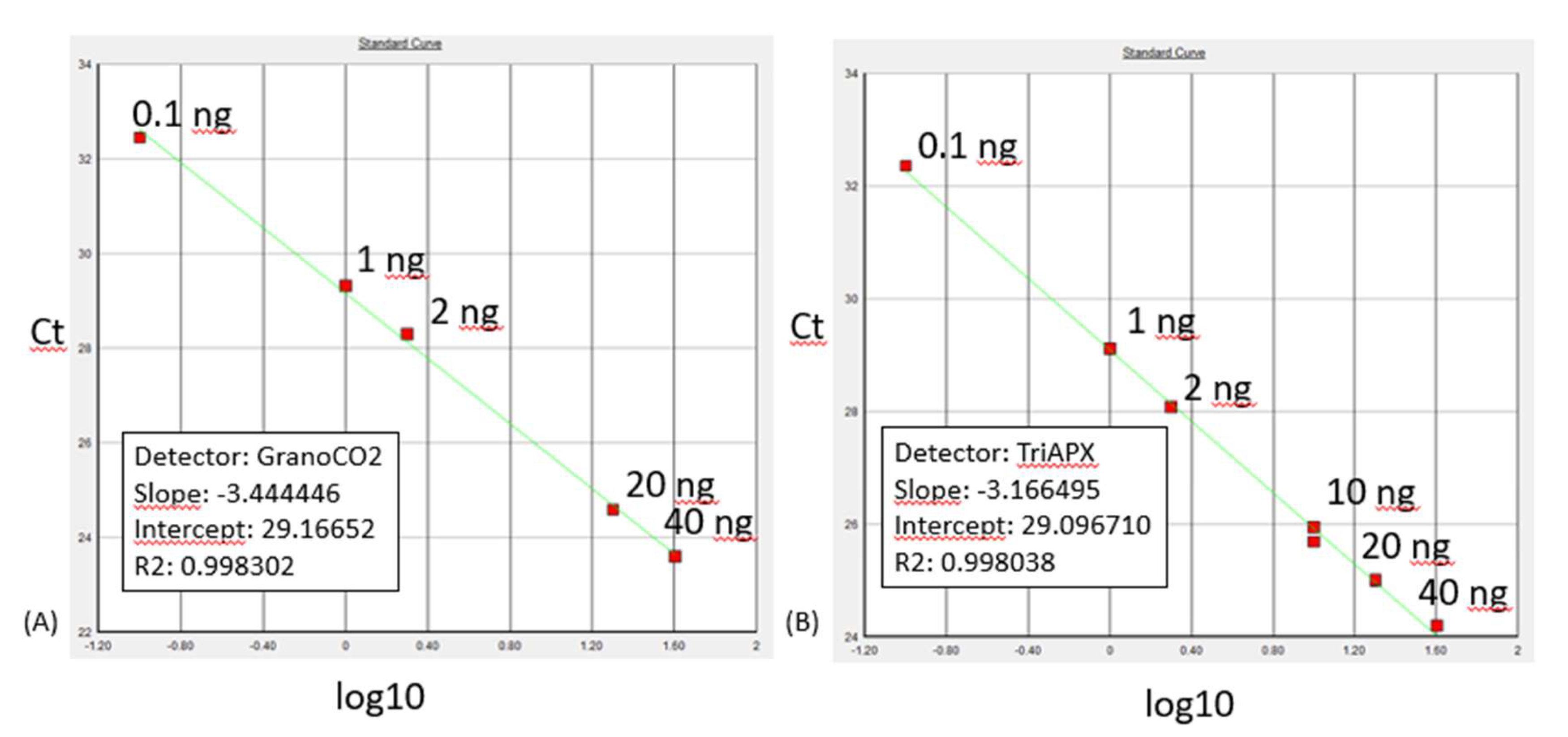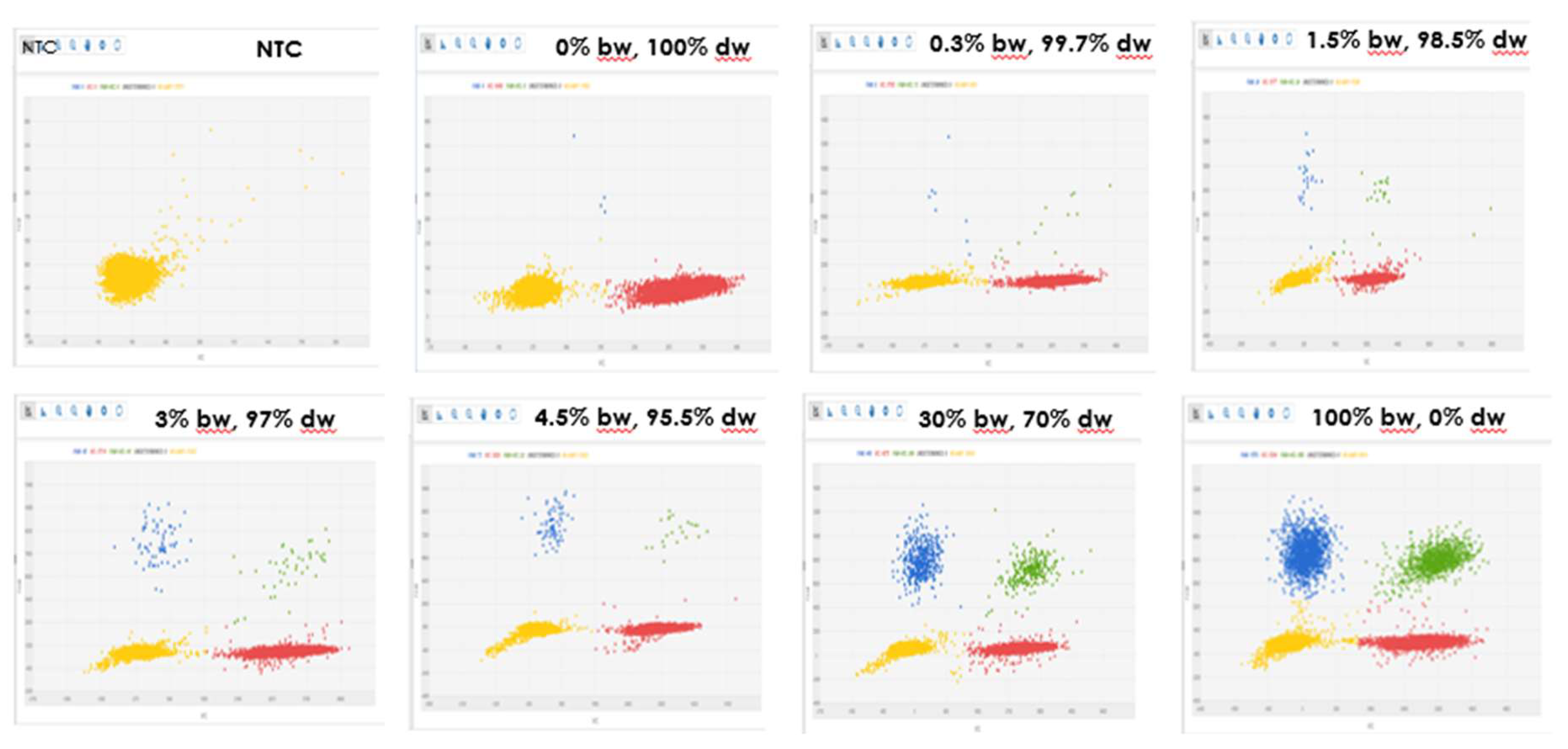A Chip Digital PCR Assay for Quantification of Common Wheat Contamination in Pasta Production Chain
Abstract
1. Introduction
2. Materials and Methods
2.1. Mono-Species Flour Samples Preparation and DNA Extraction
2.2. Mixed Species DNA Samples Preparation
- T.durum DNA 99.7% + T.aestivum DNA 0.3%;
- T.durum DNA 98.5% + T.aestivum DNA 1.5%;
- T.durum DNA 97% + T.aestivum DNA 3%;
- T.durum DNA 95.5% + T.aestivum DNA 4.5%;
- T.durum DNA 70% + T.aestivum DNA 30%
2.3. Mixed Species Flour Samples Preparation and DNA Extraction
2.4. Reference and Commercial Pasta Samples and DNA Extraction
2.5. Primers and Probes
2.6. Real-Time PCR
2.7. Chip Digital PCR
2.8. Triticum aestivum Percentage Calculation
3. Results
3.1. Reference Samples
3.2. Reference and Commercial Pasta Samples
4. Discussion
- The different level of ploidy between common wheat (hexaploid, with the three A, B and D genomes) and durum wheat (tetraploid, with A and B genomes);
- the fact that TaHd1 gene is present in single copy/A, B and D haploid genomes;
- the fact that Pinb-D1 gene is present in single copy/D haploid genome; and
- the comparable amplification efficiency of the two targets
Author Contributions
Funding
Conflicts of Interest
References
- Cacchiarelli, L.; Sorrentino, A. Pricing strategies in the Italian retail sector: The case of pasta. Soc. Sci. 2019, 8, 113. [Google Scholar] [CrossRef]
- LEGGE 4 luglio 1967, n. 580 Disciplina per la lavorazione e commercio dei cereali, degli sfarinati, del pane e delle paste alimentari. (GU Serie Generale n.189 del 29-07-1967). Available online: https://www.gazzettaufficiale.it/gazzetta/serie_generale/caricaDettaglio?dataPubblicazioneGazzetta=1967-07-29&numeroGazzetta=189 (accessed on 7 July 2020).
- DECRETO DEL PRESIDENTE DELLA REPUBBLICA 9 febbraio 2001, n. 187. Regolamento per la revisione della normativa sulla produzione e commercializzazione di sfarinati e paste alimentari, a norma dell’articolo 50 della legge 22 febbraio 1994, n. 146. (GU Serie Generale n.117 del 22-05-2001). Available online: https://www.gazzettaufficiale.it/atto/serie_generale/caricaDettaglioAtto/originario?atto.dataPubblicazioneGazzetta=2001-05-22&atto.codiceRedazionale=001A5636&elenco30giorni=false (accessed on 7 July 2020).
- DECRETO DEL PRESIDENTE DELLA REPUBBLICA 5 marzo 2013, n. 41. Regolamento recante modifiche al decreto del Presidente della Repubblica 9 febbraio 2001, n. 187, concernente la revisione della normativa sulla produzione e commercializzazione di sfarinati e paste alimentari. (13G00082) (GU Serie Generale n.95 del 23-04-2013). Available online: https://www.politicheagricole.it/flex/cm/pages/ServeBLOB.php/L/IT/IDPagina/6230 (accessed on 7 July 2020).
- Resmini, P.; De Bernardi, G. Il metodo elettroforetico rapido per il riconoscimento ed il dosaggio del grano tenero nel grano duro, negli sfarinati e nelle paste alimentari. Tecnica Molitoria 1976, 10, 97–101. [Google Scholar]
- Cantagalli, P.; Piazzi, S.E.; Sordi-Galli, S. Il controllo della genuinità delle semole di frumento duro e delle paste alimentari mediante immunologia. Tecnica Molitoria 1969, 4, 79–85. [Google Scholar]
- Boney, M. Rapid diagnostics technologies for food industrie. Food Sci. Technol. Today 1998, 12, 50–52. [Google Scholar]
- Kobrenel, K.; Gaga, O.; Autran, J.C. Possibilite de detection de la presence de bles tendres dans les pates alimentaires ayant subi des traitements thermiques a haute temperature. Annales des Falsifications et de l’Expertise Chimique et Toxicologique 1985, 78, 109–117. [Google Scholar]
- Caboni, M.F.; Iafelice, G.; Pelillo, M.; Marconi, E. Analysis of fatty steryl esters in tetraploid and hexaploid wheats: Identification and comparison between chromatographic methods. J. Agric. Food Chem. 2005, 53, 7465–7472. [Google Scholar] [CrossRef]
- Bryan, G.J.; Dixon, A.; Gale, M.D.; Wiseman, G. A PCR-based method for the detection of hexaploid bread wheat adulteration of durum wheat and pasta. J. Cereal Sci. 1998, 39, 175–180. [Google Scholar] [CrossRef]
- Arlorio, M.; Coisson, J.D.; Cereti, E.; Travaglia, F.; Papasso, M.; Martelli, A. Polymerase chain reaction (PCR) of puroindoline b and ribosomal/puroindoline b multiplex PCR for the detection of common wheat (Triticum aestivum) in Italian pasta. Eur. Food Res. Technol. 2003, 216, 253–258. [Google Scholar] [CrossRef]
- Sonnante, G.; Montemurro, C.; Morgese, A.; Sabetta, W.; Blanco, A.; Pasqualone, A. DNA microsatellite region for a reliable quantification of soft wheat adulteration in durum wheat-based foodstuffs by real-time PCR. J. Agric. Food Chem. 2009, 57, 10199–10204. [Google Scholar] [CrossRef]
- Casazza, A.P.; Morcia, C.; Ponzoni, E.; Gavazzi, F.; Benedettelli, S.; Breviario, D. A reliable assay for the detection of soft wheat adulteration in Italian pasta is based on the use of new DNA molecular markers capable of discriminating between Triticum aestivum and Triticum durum. J. Cereal Sci. 2012, 56, 733–740. [Google Scholar] [CrossRef]
- Silletti, S.; Morello, L.; Gavazzi, F.; Gianì, S.; Braglia, L.; Breviario, D. Untargeted DNA-based methods for the authentication of wheat species and related cereals in food products. Food Chem. 2019, 271, 410–418. [Google Scholar] [CrossRef]
- Alary, R.; Serin, A.; Duviau, M.P.; Joudrier, P.; Gautier, M.F. Quantification of common wheat adulteration of durum wheat pasta using real-time quantitative polymerase chain reaction (PCR). Cereal Chem. 2002, 79, 553–558. [Google Scholar] [CrossRef]
- Terzi, V.; Malnati, M.; Barbanera, M.; Stanca, A.M.; Faccioli, P. Development of analytical systems based on real-time PCR for Triticum species-specific detection and quantitation of bread wheat contamination in semolina and pasta. J. Cereal Sci. 2003, 38, 87–94. [Google Scholar] [CrossRef]
- Matsuoka, Y.; Arami, S.; Sato, M.; Haraguchi, H.; Kurimoto, Y.; Imai, S.; Tanaka, K.; Mano, J.; Furui, S.; Kitta, K. Development of methods to distinguish between durum/common wheat and common wheat in blended flour using PCR. Food Hyg. Saf. Sci. 2012, 53, 195–202. [Google Scholar] [CrossRef] [PubMed][Green Version]
- Imai, S.; Tanaka, K.; Nishitsuji, Y.; Kikuchi, Y.; Matsuoka, Y.; Arami, S.; Sato, M.; Haraguchi, H.; Kurimoto, Y.; Mano, J.; et al. An endogenous reference gene of common and durum wheat for detection of genetically modified wheat. Food Hyg. Saf. Sci. 2012, 53, 203–210. [Google Scholar] [CrossRef] [PubMed]
- Paternò, A.; Verginelli, D.; Bonini, P.; Misto, M.; Quarchioni, C.; Dainese, E.; Peddis, S.; Fusco, C.; Vinciguerra, D.; Marchesi, U. In-House Validation and Comparison of Two Wheat (Triticum aestivum) Taxon-Specific Real-Time PCR Methods for GMO Quantification Supported by Droplet Digital PCR. Food Anal. Methods 2018, 11, 1281–1290. [Google Scholar] [CrossRef]
- Morcia, C.; Ghizzoni, R.; Gianinetti, A.; Avossa, V.; Scaramagli, S.; Carnevali, P.; Terzi, V. Validation of a DNA-based method for bread wheat contamination detection in pasta. J. Cereal Sci. 2017, 76, 69–71. [Google Scholar] [CrossRef]
- Corbisier, P.; Barbante, A.; Berben, G.; Broothaerts, W.; De Loose, M.; Emons, H.; Georgieva, T.; Lievens, A.; Mazzara, M.; Papazova, N.; et al. Recommendation for the Unit of Measurement and the Measuring System to Report Traceable and Comparable Results Expressing GM Content in Accordance with EU Legislation; EUR28536 EN; Publications Office of the European Union: Luxembourg, 2017. [Google Scholar] [CrossRef]
- Cottenet, G.; Blancpain, C.; Chuah, P.F. Performance assessment of digital PCR for the quantification of GM-maize and GM-soya events. Anal. Bioanal. Chem. 2019, 411, 2461–2469. [Google Scholar] [CrossRef]
- Dong, X.; Gao, D.; Dong, J.; Chen, W.; Li, Z.; Wang, J.; Liu, J. Mass ratio quantitative detection for kidney bean in lotus seed paste using duplex droplet digital PCR and chip digital PCR. Anal. Bioanal. Chem. 2020, 412, 1701–1707. [Google Scholar] [CrossRef]
- Nemoto, Y.; Kisaka, M.; Fuse, T.; Yano, M.; Ogihara, Y. Characterization and functional analysis of three wheat genes with homology to the CONSTANS flowering time gene in transgenic rice. Plant J. 2003, 36, 82–93. [Google Scholar] [CrossRef]
- CXG 74-2010 Guidelines on Performance Criteria and Validation of Methods for Detection, Identification and Quantification of Specific DNA Sequences and Specific Proteins in Foods 2010. Available online: http://www.fao.org/fao-who-codexalimentarius/codex-texts/guidelines/en/ (accessed on 6 June 2020).
- ENGL, European Network of GMO Laboratories. Definition of Minimum Performance Requirements for Analytical Methods of GMO Testing. 2015. Available online: http://gmo-crl.jrc.ec.europa.eu/doc/MPR%20Report%20Application%2020_10_2015.pdf (accessed on 6 June 2020).
- Demeke, T.; Dobnik, D. Critical assessment of digital PCR for the detection and quantification of genetically modified organisms. Anal. Bioanal. Chem. 2018, 410, 4039–4050. [Google Scholar] [CrossRef] [PubMed]
- Pecoraro, S.; Berben, G.; Burns, M.; Corbisier, P.; De Giacomo, M.; De Loose, M.; Dagand, E.; Dobnik, D.; Eriksson, R.; Holst-Jensen, A.; et al. Overview and Recommendations for the Application of Digital PCR; EUR 29673 EN; Publications Office of the European Union: Luxembourg, 2019; ISBN 978-92-76-00180-5, JRC115736. [Google Scholar] [CrossRef]
- Mehle, N.; Gregur, L.; Bogožalec Košir, A.; Dobnik, D. One-Step Reverse-Transcription Digital PCR for Reliable Quantification of Different Pepino Mosaic Virus Genotypes. Plants 2020, 9, 326. [Google Scholar] [CrossRef] [PubMed]
- Dong, L.; Meng, Y.; Wang, J.; Liu, Y. Evaluation of droplet digital PCR for characterizing plasmid reference material used for quantifying ammonia oxidizers and denitrifiers. Anal. Bioanal. Chem. 2014, 406, 1701–1712. [Google Scholar] [CrossRef] [PubMed]
- Pavšič, J.; Žel, J.; Milavec, M. Assessment of the real-time PCR and different digital PCR platforms for DNA quantification. Anal. Bioanal. Chem. 2016, 408, 107–121. [Google Scholar] [CrossRef]
- Debski, P.; Gewartowski, K.; Bajer, S.; Garsteki, P. Calibration-free assays on standard real-time PCR devices. Sci. Rep. 2017, 7, 44854. [Google Scholar] [CrossRef]
- Bhave, M.; Morris, C.F. Molecular genetics of puroindolines and related genes: Allelic diversity in wheat and other grasses. Plant Mol. Biol. 2008, 66, 205–219. [Google Scholar] [CrossRef]



| Name | Primer Sequence (5′-3′) | Gene | Target |
|---|---|---|---|
| GranoCO2- Forward | TGCTAACCGTGTGGCATCAC | Triticum TaHd1 | Triticum genus |
| GranoCO2 Reverse | GGTACATAGTGCTGCTGCATCTG | ||
| GranoCO2 probe | VIC- CATGAGCGTGTGCGTG -MGB | ||
| TritA_APX Forward | AGGAGCGGCCGAAGCT | Pinb-D1 | Triticum aestivum |
| TritA_APX Reverse | TGTGAAACATCGCTCCATCAC | ||
| TritA_APX probe | FAM-AGCTCTTGCAAGGAT -MGB |
| Actual Common Wheat % | Mixed DNA | Mixed Flour | ||||||||
|---|---|---|---|---|---|---|---|---|---|---|
| Mean Common Wheat % | Std Dev | CV | Absolute Error | Relative Error | Mean Common Wheat % | Std Dev | CV | Absolute Error | Relative Error | |
| 0 | 0.12 | 0.05 | 0.39 | 0.12 | 0.09 | 0.06 | 0.65 | 0.09 | ||
| 100 | 105.00 | 7.00 | 0.07 | 5.00 | 0.05 | 94.40 | 6.85 | 0.07 | 5.60 | 0.06 |
| 0.3 | 0.43 | 0.05 | 0.12 | 0.13 | 0.43 | 0.37 | 0.12 | 0.34 | 0.07 | 0.23 |
| 1.5 | 1.37 | 0.07 | 0.05 | 0.13 | 0.09 | 1.43 | 0.28 | 0.19 | 0.07 | 0.05 |
| 3 | 3.06 | 0.05 | 0.01 | 0.06 | 0.02 | 2.86 | 0.32 | 0.11 | 0.14 | 0.05 |
| 4.5 | 4.50 | 0.04 | 0.01 | 0.00 | 0.00 | 3.93 | 0.51 | 0.13 | 0.57 | 0.13 |
| 30 | 25.90 | 0.46 | 0.02 | 4.10 | 0.14 | 24.90 | 1.68 | 0.07 | 5.10 | 0.17 |
© 2020 by the authors. Licensee MDPI, Basel, Switzerland. This article is an open access article distributed under the terms and conditions of the Creative Commons Attribution (CC BY) license (http://creativecommons.org/licenses/by/4.0/).
Share and Cite
Morcia, C.; Bergami, R.; Scaramagli, S.; Ghizzoni, R.; Carnevali, P.; Terzi, V. A Chip Digital PCR Assay for Quantification of Common Wheat Contamination in Pasta Production Chain. Foods 2020, 9, 911. https://doi.org/10.3390/foods9070911
Morcia C, Bergami R, Scaramagli S, Ghizzoni R, Carnevali P, Terzi V. A Chip Digital PCR Assay for Quantification of Common Wheat Contamination in Pasta Production Chain. Foods. 2020; 9(7):911. https://doi.org/10.3390/foods9070911
Chicago/Turabian StyleMorcia, Caterina, Raffaella Bergami, Sonia Scaramagli, Roberta Ghizzoni, Paola Carnevali, and Valeria Terzi. 2020. "A Chip Digital PCR Assay for Quantification of Common Wheat Contamination in Pasta Production Chain" Foods 9, no. 7: 911. https://doi.org/10.3390/foods9070911
APA StyleMorcia, C., Bergami, R., Scaramagli, S., Ghizzoni, R., Carnevali, P., & Terzi, V. (2020). A Chip Digital PCR Assay for Quantification of Common Wheat Contamination in Pasta Production Chain. Foods, 9(7), 911. https://doi.org/10.3390/foods9070911






